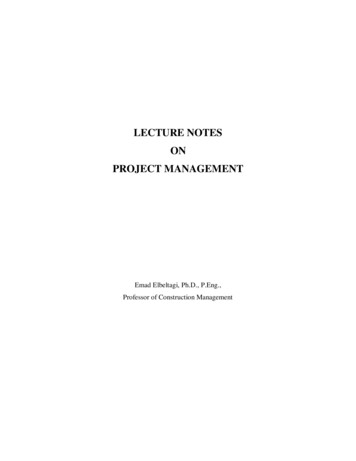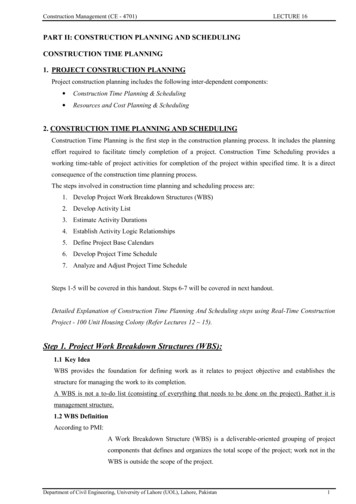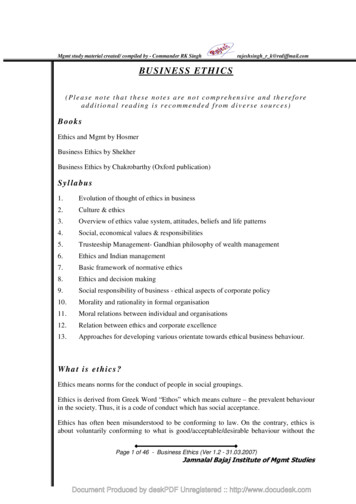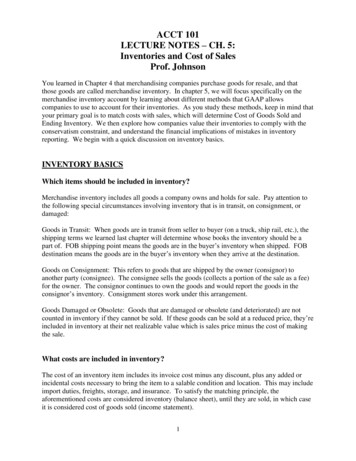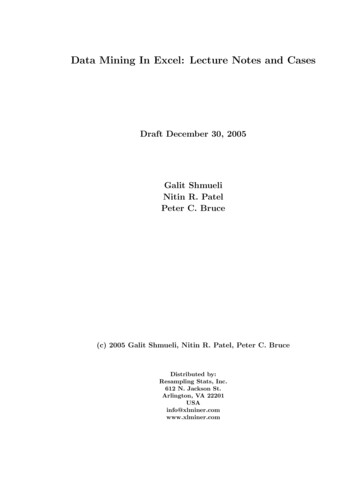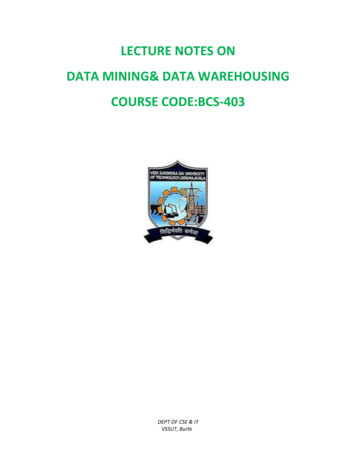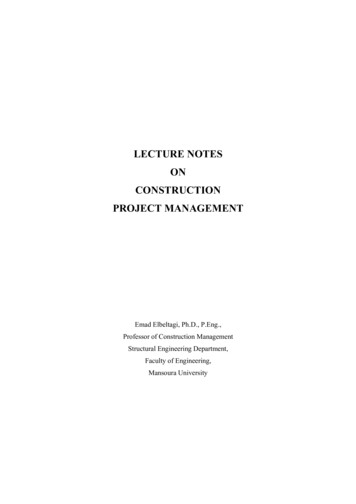
Transcription
LECTURE NOTESONCONSTRUCTIONPROJECT MANAGEMENTEmad Elbeltagi, Ph.D., P.Eng.,Professor of Construction ManagementStructural Engineering Department,Faculty of Engineering,Mansoura University
Construction Project Management2009Copyright 2009 by the author. All rights reserved. No part of this book may bereproduced or distributed in any form or by any means, or stored in a data base orretrieval system, without the prior written permissions of the author.
PREFACEIn the Name of ALLAH the Most Merciful, the Most CompassionateAll praise is due to ALLAH and blessings and peace be upon His messenger and servant,Muhammad, and upon his family and companions and whoever follows his guidanceuntil the Day of Resurrection.Construction project management is a relatively young field. However, its impact hasbeen quite remarkable. It has become an important practice for improving the efficiencyof construction operations around the world. This book deals with some topics and toolsof the large field of project management.This book is dedicated mainly to undergraduate engineering students, especially CivilEngineering students where most of the applications are presented in the civil engineeringfield. It provides the reader with the main knowledge to manage a construction projectfrom preliminary stages to handover. It includes eight chapters: Chapter 1 provides ageneral introduction to construction projects in terms of their types, project life cycle andthe main players involved. Chapter 2 is dedicated for the contract strategy. The planningstages of a construction project are presented in chapter 3. Chapter 4 is dedicated forpresenting different scheduling techniques along with the schedule representation.Chapter 5 is dedicated to discuss the scheduling methods on non-deterministic activitydurations. The scheduling of linear projects is presented in chapter 6. Chapter 7 is dealingwith both the resource scheduling and smoothing problems. The schedule compression is,also, presented in chapter 8. Chapter 9 is dedicated for the project finance and cash flowanalysis. Finally, chapter 01 is dedicated for project control. Many solved examples havebeen added to enable the students to understand the material presented in this book. Also,each chapter is followed by exercises for training purposes.Finally, May ALLAH accepts this humble work and I hope it will be beneficial to itsreaders.i
TABLE OF CONTENTSCHAPTER 1: INTRODUCTION1.1 The Need for Project Management11.2 The Construction Project21.3 The Project Scope and Goals31.4 The Project Life-Cycle61.4.1 Preconstruction phase91.4.2 Procurement phase (Bidding and award phase)101.4.3 Construction Phase101.4.4 Closeout Phase111.5 Major Types of Construction Projects111.5.1 Residential Housing Construction111.5.2 Institutional and Commercial Building Construction121.5.3 Specialized Industrial Construction131.5.4 Infrastructure and Heavy Construction131.6 Construction Projects Participants141.6.1 The Owner (Client)141.6.2 The Design Professionals151.6.3 The Construction Professionals151.6.4 The Project Manager161.7 Exercises17CHAPTER 2: CONTRACT STRATEGY2.1 What is a Contract192.2 Selection of Contract Type202.2.1 Project Objectives212.2.2 Project Constraints222.3 Project Delivery Methods23ii
2.3.1 Traditional Approach232.3.2 Direct Labor242.3.3 Design-Build242.3.4 Turnkey252.3.5 Build-Operate-Transfer (BOT)252.3.6 Professional Construction Management (PCM)262.3.7 Contractual Relationships262.4 Types of Contracts282.4.1 Lump-sum Contract282.4.2 Admeasurement Contract292.4.3 Cost-reimbursable Contract (cost-plus contract)302.4.4 Target Cost Contract302.4.5 Time and Material (T&M) Contract312.5 Contract Administration312.5.1 Contract Documents322.5.2 Conditions of Contract332.5.3 The Standard (general) Forms of Conditions of Contract342.5.4 Special Conditions of Contract362.5.4 Construction claims Contract372.6 Selecting the Contractor382.7 Sub-Contracting382.8 Exercises39CHAPTER 3: PROJECT PLANNING3.1 Introduction423.2 Project Planning Steps433.2.1 Work Breakdown Structure (WBS)44WBS and organizational breakdown structure (OBS)47WBS coding47iii
3.2.2 Project Activities483.2.3 Activities Relationships52Logical relationship considering resource constraints54Overlap or lag55Types of activities relationships583.2.4 Drawing Project Network58Activity on arrow network (AOA)59Activity on node network (AON)60Comparison between AOA and AON613.3 Estimating Activity Duration and Direct Cost653.4 Exercises68CHAPTER 4: PROJECT SCHEDULING4.1 The Critical Path Method754.2 Calculations for the Critical Path Method764.2.1 Activity-On-Arrow Networks Calculations76Forward path77Backward path79Float calculations81Identifying the Critical Activities834.2.2 Precedence Diagram Method (PDM)834.3 Time-Scaled Diagrams844.4 Schedule Presentation884.5 Criticisms to Network Techniques894.6 Solved Examples904.6.1 Example 1904.6.2 Example 2914.6.3 Example 3924.6.4 Example 4934.7 Exercises94iv
CHAPTER 5: STOCHASTIC SCHEDULING5.1 Scheduling with Uncertain Durations1005.1.1 Program Evaluation and Review Technique1025.1.2 Criticism to Program Evaluation and Review Technique1095.2 Monte Carlo Simulation1105.2.1 Monte Carlo Simulation Characteristics1105.2.2 Monte Carlo Simulation Process1105.2.3 Criticality Index1135.3 Exercises113CHAPTER 6: SCHEDULING OF LINEAR PROJECTS6.1 Linear Projects1166.2 Resource-Driven Scheduling1176.3 Summary Diagrams1176.3.1 Summary Diagrams Using One Relationship1176.3.2 Summary Diagrams Using Two Relationships1206.4 Line of Balance (LOB)1236.4.1 Basic Representation1236.4.2 LOB Calculations125Crew synchronization126Meeting a deadline duration127Calculating resource needs128Drawing the LOB Schedule1306.5 Exercises134CHAPTER 7: RESOURCES MANAGEMENT7.1 Resource Definition1367.2 Resource Management137Resource leveling (smoothing)138Resource scheduling138v
7.3 Resource Allocation1297.4 Resource Aggregation (Loading)1297.5 Resource Leveling (Smoothing)1417.5.1 Method of Moments for Resource Smoothing1427.5.2 Heuristic Procedure for Resource Smoothing1437.6 Scheduling with Limited Resource1527.7 Case Study1547.8 Exercises161CHAPTER 8: PROJECT TIME-COST TRADE-OFF8.1 Time-Cost Trade-Off1648.2 Activity Time-Cost Relationship1658.3 Project Time-Cost Relationship1698.4 Shortening Project Duration1708.5 Exercises180CHAPTER 9: PROJECT FINANCE AND CONTRACT PRICING9.1 Contract Cash Flow1829.1.1 Construction Project Costs183Project direct costs183Project indirect costs1849.1.2 The S-Curve1869.1.3 Project Income (Cash-in)1889.1.4 Calculating Contract Cash Flow1909.1.5 Minimizing Contractor Negative Cash Flow1959.1.6 Cost of Borrowing (Return on Investment)1979.2 Project Cash Flow2029.2.1 Project Profitability Indicators2039.3 Discounted Cash Flow2059.3.1 Present Value2059.3.2 Net Present Value (NPV)206vi
9.3.3 Internal Rate of Return (IRR)2079.4 Finalizing a Tender Price2089.4.1 Estimating Profit Margin2099.4.2 Risk Management209Risk Identification210Response to Risk and Uncertainties213Risk Analysis2149.5 Pricing Policy2179.5.1 Balanced bid (straight forward method)2179.5.2 Unbalanced bid (Loading of Rates)2189.5.3 Method Related Charge2229.6 Exercises225CHAPTER 10: PROJECT CONTROL10.1 Problems that may Arise During Construction22910.2 Schedule Updating23010.3 Delays Analysis23410.3.1 Types of Delays23410.3.2 The As-Built Schedule23610.3.3 Analysis of Concurrent Delays23710.4 Earned Value Management240Budgeted Cost of Work Scheduled (BCWS)241Budgeted Cost of Work Performed (BCWP)241Actual Cost of Work Performed (ACWP)24110.5 Exercises245REFERENCES248vii
CHAPTER 1INTRODUCTION1.1The Need for Project ManagementThe construction industry is the largest industry in the world. It is more of a service thana manufacturing industry. Growth in this industry in fact is an indicator of the economicconditions of a country. This is because the construction industry consumes a wideemployment circle of labor. While the manufacturing industry exhibit high-qualityproducts, timelines of service delivery, reasonable cost of service, and low failure rates,the construction industry, on the other hand, is generally the opposite. Most projectsexhibit cost overruns, time extensions, and conflicts among parties. Figure 1.1 is anexample of a complicated project. Table 1.1, also, exhibits some magnificent projects thatsuffered from huge cost overruns.Figure 1.1: Example of a complicated projectConstruction Management1Dr. Emad Elbeltagi
Table 1.1: Magnificent projects with huge cost overrunsProjectSuez CanalCost overruns (%)1,900Sydney Opera House1,400Concorde Supersonic Aeroplane1,100Panama Canal200Brooklyn Bridge100(Source: Mette K. Skamris, 'Economic Appraisal of Large-Scale TransportInfrastructure Investments', Ph.D dissertation, Aalborg University, 2000).In general, the construction industry is more challenging than other industries due to: itsunique nature; every project is one-of a kind; many conflicting parties are involved;projects are constrained by time, money and quality; and high risk.1.2The Construction ProjectA project is defined, whether it is in construction or not, by the following characteristics:- A defined goal or objective.- Specific tasks to be performed.- A defined beginning and end.- Resources being consumed.The goal of construction project is to build something. What differentiate the constructionindustry from other industries is that its projects are large, built on-site, and generallyunique. Time, money, labor, equipment, and, materials are all examples of the kinds ofresources that are consumed by the project.Projects begin with a stated goal established by the owner and accomplished by theproject team. As the team begins to design, estimate, and plan out the project, themembers learn more about the project than was known when the goal was firstestablished. This often leads to a redefinition of the stated project goals.Construction Management2Dr. Emad Elbeltagi
1.3The Project Scope and GoalsProject Goal SettingYou can’t hit a target if you don’t know what it looks like. Similarly, you can’t possiblyreach your project’s goal if you don’t know what it is. When you understand how yourproject fits in with the broader company direction, it’s time to really pin down your goal.“But,” you say, “I know exactly what my goal is, because my boss told me.” However, aset of deliverables isn’t necessarily a goal. On first consideration, you might say the goalof expanding the railroad westward in the United States was to enable a train to go fromcoast to coast. But was it? Perhaps the goal of those railroad barons was not to get a trainto go cross country, but to open up opportunities for commerce in the West. It’s time toput the same kind of thought to your project’s goal.Getting your goal straightSay your project involves training new employees in a new software system. Your goal intraining them on this software could be to:-Make employees more productive in their jobs.-Enable employees to better serve customers.-Create a prototype program with reduced training costs that can be used to reduceoverall training costs across the company.-Increase employee retention by providing useful on-the-job skills. These goalssuggest different priorities as well as different measurements for gauging thedegree to which your project has succeeded in meeting its goal.How, exactly, do you go about determining your goal? First, go back to the person whoasked you to take on the project and grill him or her about what’s expected of this project.Should the training have a measurable impact on job performance, customer satisfaction,employee retention, or cost of delivery? The answer you get might be that the projectshould do all of these things. But think about whether that’s realistic and whether one ofthese goals should be paramount in guiding you and your project team. If overall trainingprogram cost reduction is the biggest goal factor, for example, employee productivityConstruction Management3Dr. Emad Elbeltagi
might have to take a back seat when you’re making choices along the way. If customersatisfaction is the real goal, training costs might have to be adjusted accordingly.Writing a goal statementAfter you get more specifics about your project’s goal, it’s a good idea to put your goal inwriting in a goal statement. A goal statement outlines why you’re doing this project andwhat you hope to accomplish at the end. You don’t get down to specific deliverables andparameters in a goal statement. For now focus on the why and the desired result.Here are a few sample goal statements:-The goal of the project is to upgrade the shopping cart feature on our Web site tobe easier to use so we can increase online sales by 25 percent.-Our goal is to reduce human resource workload by 10 percent by offering selfservice information on job benefits on the company intranet.Using the example of a training project, consider for a moment what such a project mightinvolve. Are you supposed to write new training materials, hire staff to deliver classes,analyze the training’s effectiveness, update training materials as needed, and promote thetraining internally? In that case, the scope of your project involves managing the entirecreation, delivery, and maintenance of a training program. Or is your goal to simplycreate the training materials? Or should your focus be limited to launching the newtraining, including promoting it to management and staff? These goals indicate verydifferent projects, each with its own set of deliverables, tasks, resources, schedule, andcosts. Writing a goal statement helps you focus on such a project from the outset.Project scopeWhen you understand your goal, you can begin to define the specific parameters of theproject. This is often referred to as a project’s scope. It is necessary to know that a scopeis not a goal. Take a look again at this goal statement from the previous section: The goalof the project is to u
Construction project management is a relatively young field. However, its impact has been quite remarkable. It has become an important practice for improving the efficiency of construction operations around the world. This book deals with some topics and tools of the large field of project management. This book is dedicated mainly to undergraduate engineering students, especially Civil .File Size: 356KBPage Count: 27


